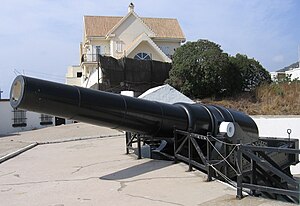Our website is made possible by displaying online advertisements to our visitors.
Please consider supporting us by disabling your ad blocker.
100-ton gun
This article includes a list of general references, but it lacks sufficient corresponding inline citations. (September 2016) |
| Armstrong 100-ton gun | |
|---|---|
 "Rockbuster" at Napier of Magdala Battery, Gibraltar | |
| Type | Naval gun Coast defence gun |
| Place of origin | United Kingdom |
| Service history | |
| In service | 1877-1906 |
| Production history | |
| Designer | Elswick Ordnance Company |
| Unit cost | £16,000[1] (£176,000 today) |
| No. built | 15[2] |
| Specifications | |
| Mass | 103 tons |
| Barrel length | bore: 363.0 inches (9.22 m) (20.5 calibres)[3] |
| Shell | HE, AP, Shrapnel, 2,000 pounds (910 kg)[4] |
| Calibre | 450-millimetre (17.72 in)[3] |
| Recoil | 1.75 m (5 ft 9 in) |
| Elevation | 10° 30' |
| Traverse | 150° |
| Muzzle velocity | 1,548 feet per second (472 m/s) (Firing a 1,968 lb projectile with 450 lb Prism powder propellant)[5] |
| Maximum firing range | 6,600 yards (6,000 m) |
The 100-ton gun (also known as the Armstrong 100-ton gun)[6] was a british coastal defense gun and is the world's largest black powder cannon. It was a 17.72-inch (450 mm) rifled muzzle-loading (RML) gun made by Elswick Ordnance Company, the armaments division of the British manufacturing company Armstrong Whitworth, owned by William Armstrong. The 15 guns Armstrong made were used to arm two Italian battleships and, to counter these, British fortifications at Malta and Gibraltar.
- ^ Brassey 1882, p. 95.
- ^ Italy : 8 for Duilio and Dandolo, 1 for Spezia defences, 2 spare. Britain : 2 for Malta, 2 for Gibraltar. Campbell, "British Super-Heavy Guns".
- ^ a b Mackinlay 1887, p. Table XVI, Page 312.
- ^ Textbook of Gunnery 1902.
- ^ Mackinlay 1887, p. Table XVI, Page 313.
- ^ Possner 2009.
Previous Page Next Page


